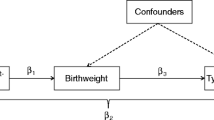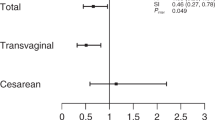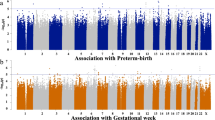Abstract
The aim of this study was to test the impact of variants rs900400 (located near LEKR1 and CCNL1) and rs9883204 (located in ADCY5) on birth weight in a Chinese population. We conducted a case–control study including 156 low-birth- weight infants as the case group and 100 normal-birth-weight infants as the control group. The rs900400 and rs9883204 variants were analyzed by gene sequencing in all the participants. Our results revealed a significant difference in the genotype distribution (χ2 = 10.449, p = 0.005) and allele distribution (χ2 = 9.277, p = 0.002) of rs900400 between the case group and the control group. The C allele of rs900400 was associated with lower birth weight (OR 1.771 [95 % CI 1.237–2.535]) in the Chinese population. However, the rs9883204 polymorphism was not informative in the Chinese population. Our study shows that the “birth weight-lowering” variant rs900400 located near LEKR1 and CCNL1, which is strongly associated with birth weight in European cohorts, appears to have a similar association in Chinese cohorts. However, the rs9883204 variant located in ADCY5 does not appear to be correlated with low birth weight in the same population. Moreover, we found that the variant rs900400 may also be associated with premature birth, thereby supporting the need for further research in this area.
Similar content being viewed by others
References
Acker DB, Sachs BP, Friedman EA (1985) Risk factors for shoulder dystocia. Obstet Gynecol 66:762–768
Babenko AP, Polak M, Cavé H, Busiah K, Czernichow P, Scharfmann R, Bryan J, Aguilar-Bryan L, Vaxillaire M, Froguel P (2006) Activating mutations in the ABCC8 gene in neonatal diabetes mellitus. N Engl J Med 355:456–466
Barker DJ, Hales CN, Fall CH, Osmond C, Phipps K, Clark PM, Clark PM (1993) Type 2 (non-insulin-dependent) diabetes mellitus, hypertension and hyperlipidaemia (syndrome X): relation to reduced fetal growth. Diabetologia 36:62–67
Battaglia FC, Lubchenco LO (1967) A practical classification of newborn infants by weight and gestational age. J Pediatr 71:159–163
Clausson B, Lichtenstein P, Cnattingius S (2000) Genetic influence on birthweight and gestational length determined by studies in offspring of twins. BJOG 107:375–381
Dupuis J, Langenberg C, Prokopenko I et al (2010) New genetic loci implicated in fasting glucose homeostasis and their impact on type 2 diabetes risk. Nat Genet 42:105–116
Edghill EL, Bingham C, Slingerland AS, Minton JA, Noordam C, Ellard S, Hattersley AT (2006) Hepatocyte nuclear factor-1 beta mutations cause neonatal diabetes and intrauterine growth retardation: support for a critical role of HNF-1beta inhuman pancreatic development. Diabet Med 23:1301–1306
Emanuel I, Filakti H, Alberman E, Evans SJ (1992) Intergenerational studies of human birthweight from the 1958 birth cohort 1. Evidence for a multigenerational effect. Br J Obstet Gynaecol 99:67–74
Freathy RM, Mook-Kanamori DO, Sovio U et al (2010) Variants in ADCY5 and near CCNL1 are associated with fetal growth and birth weight. Nat Genet 42:430–435
Hanoune J, Pouille Y, Tzavara E, Shen T, Lipskaya L, Miyamoto N, Suzuki Y, Defer N (1997) Adenylyl cyclases: structure, regulation and function in an enzyme superfamily. Mol Cell Endocrinol 128:179–194
Hattersley AT, Tooke JE (1999) The fetal insulin hypothesis: an alternative explanation of the association of low birth weight with diabetes and vascular disease. Lancet 353:1789–1792
Järvelin MR, Elliott P, Kleinschmidt I, Martuzzi M, Grundy C, Hartikainen AL, Rantakallio P (1997) Ecological and individual predictors of birthweight in a northern Finland birth cohort 1986. Paediatr Perinat Epidemiol 11:298–312
Järvelin MR, Sovio U, King V, Lauren L, Xu B, McCarthy MI, Hartikainen AL, Laitinen J, Zitting P, Rantakallio P et al (2004) Early life factors and blood pressure at age 31 years in the 1966 northern Finland birth cohort. Hypertension 44:838–846
Klebanoff MA, Meirik O, Berendes HW (1989) Second-generation consequences of small-for-dates birth. Pediatrics 84:343–347
Klebanoff MA, Mednick BR, Schulsinger C, Secher NJ, Shiono PH (1998) Father’s effect on infant birth weight. Am J Obstet Gynecol 178:1022–1026
Knight B, Shields BM, Turner M, Powell RJ, Yajnik CS, Hattersley AT (2005) Evidence of genetic regulation of fetal longitudinal growth. Early Hum Dev 81:823–831
Kramer MS (1987) Determinants of low birth weight: methodological assessment and meta-analysis. Bull World Health Organ 65:663–737
Lou HC, Hansen D, Nordentoft M, Pryds O, Jensen F, Nim J, Hemmingsen R (1994) Prenatal stressors of human life affect fetal brain development. Dev Med Child Neurol 36:826–832
Ludwig MG, Seuwen K (2002) Characterization of the human adenylyl cyclase gene family: cDNA, gene structure, and tissue distribution of the nine isoforms. J Recept Signal Transduct Res 22:79–110
Magnus P (1984) Causes of variation in birth weight: a study of offspring of twins. Clin Genet 25:15–24
Mook-Kanamori DO, Marsh JA, Warrington NM, Taal HR, Newnham JP, Beilin LJ, Lye SJ, Palmer LJ, Hofman A, Steegers EA et al (2011) Variants near CCNL1/LEKR1 and in ADCY5 and fetal growth characteristics in different trimesters. J Clin Endocrinol Metab 96:2010–2316
Peterson J, Taylor HG, Minich N, Klein N, Hack M (2006) Subnormal head circumference in very low birth weight children: neonatal correlates and school age consequences. Early Hum Dev 82:325–334
Ryckman KK, Feenstra B, Shaffer JR, Bream EN, Geller F, Feingold E, Weeks DE, Gadow E, Cosentino V, Saleme C et al (2012) Replication of a genome-wide association study of birth weight in preterm neonates. J Pediatr 160:19–24
Støy J, Edghill EL, Flanagan SE, Ye H, Paz VP, Pluzhnikov A, Below JE, Hayes MG, Cox NJ, Lipkind GM et al (2007) Insulin gene mutations as a cause of permanent neonatal diabetes. Proc Natl Acad Sci USA 104:15040–15044
Tapia-Rombo CA, Ugarte-Torres RG, Alvarez-Vázquez E, Salazar- Acuña AH (2001) Risk factors for intrahospital infection in newborns. Arch Med Res 32:304–311
Tesmer JJ, Sprang SR (1998) The structure, catalytic mechanism and regulation of adenylyl cyclase. Curr Opin Struct Biol 8:713–719
Vasan SK, Neville MJ, Antoisamy B, Samuel P, Fall CH, Geethanjali FS, Thomas N, Raghupathy P, Brismar K, Karpe F (2011) Absence of birth-weight lowering effect of ADCY5 and near CCNL, but association of impaired glucose-insulin homeostasis with ADCY5 in Asian Indians. PLoS One 6:e21331
Vik T, Vatten L, Markestad T, Ahlsten G, Jacobsen G, Bakketeig LS (1996) Morbidity during the first year of life in small for gestational age infants. Arch Dis Child Fetal Neonatal Ed 75:F33–F37
Acknowledgments
We are grateful for the participation of all the patients and their families. This work was partially supported by the Dongguan Bureau of Science and Technology for the City Key Program of Science and Technology (Project Number: 2012105102026).
Author information
Authors and Affiliations
Corresponding author
Ethics declarations
Conflict of Interest
The authors declare that they have no conflict of interest.
Ethics Statement
The study was approved by the Institutional Ethics Committee of the Eighth People’s Hospital of Dongguan (Children’s Hospital of Dongguan). Informed written consent was obtained from the parents or guardians on behalf of the infant participants.
Additional information
Xuejin Fan, Qi Peng, and Yanhua Chen have contributed equally.
Rights and permissions
About this article
Cite this article
Fan, X., Peng, Q., Chen, Y. et al. Study of the relationship between variants near CCNL1/LEKR1 and in ADCY5 with low birth weight in a Chinese population. Genes Genom 37, 985–989 (2015). https://doi.org/10.1007/s13258-015-0328-8
Received:
Accepted:
Published:
Issue Date:
DOI: https://doi.org/10.1007/s13258-015-0328-8




